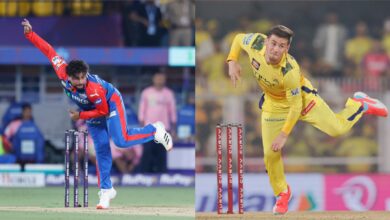Angelo Mathews timed out; why wasn’t Sourav Ganguly not timed out even when he came out to bat once after 6 minutes? | Cricket-world-cup News

MCC’s time out law reads thus: Law 40.1.1 After the fall of a wicket or the retirement of a batter, the incoming batter must, unless Time has been called, be ready to receive the ball, or for the other batter to be ready to receive the next ball within 2 minutes of the dismissal or retirement. If this requirement is not met, the incoming batter will be out, Timed out.The timed out as a method of dismissal was added to the Laws in the 1980 code. In the 2000 code it was revised to 3 minutes, though the playing conditions in this world cup gives the incoming batsman just 2 minutes. The first printed Laws of cricket, in 1775, required the umpires to allow “Two Minutes for each Man to come in when one is out”. Here is a look at some previous episodes from first-class cricket.
Those damn water-logged roads: Who was the first batsman to be timed out in first-class cricket?
South Africa’s Andrew Jordan was declared timed-out retrospectively nearly 15 years after the event. In a 1987 domestic game, Eastern Province’s Jordan was unbeaten overnight against Transvaal in Port Elizabeth. But he couldn’t come to the ground the next day in time as the streets were waterlogged after heavy rains. He was declared Timed out. This was a game organised the South African board for non-white players during the apartheid era. And in early 2000’s, it was recognised as a first-class game retrospectively after the apartheid policy was abolished. And Jordan was recorded as ‘Timed-out’.
Follow all the action from the Cricket World Cup 2023 on our special World Cup section. You can also find the latest stats, like the top scorer and the highest wicket-taker of the current edition, upcoming World Cup fixtures and the points table on the site.
Chatting over batting: Any Indian in this elite l of timed-out?
In fact, before Jordan’s introduction into the l, Tripura’s Hemulal Yadav was the first recorded batsman dismissed Timed out in 1997. His reasons for not coming in are as Indian as it gets: he was busy chatting, just beyond the boundary.
When the ninth wicket had fallen, Yadav was just beyond the boundary, and the umpires had called drinks. Yadav continued talking with his team manager. Not sure what the interesting conversation was about, as neither did he budge nor did the manager nudge him. And when the Orissa players appealed – Debasis Mohanty was playing that game, incidentally- the umpires ruled Yadav timed-out. One assumes, he continued with the chat.
War-victim? Sorry can’t help – the real first incident of timed-out
Everything about this is extraordinary – even Harold Heygate’s exence in Sussex’s playing XI. On the morning of the game in 1919, Sussex had found themselves with only 10 players and on spotting their former player Heygate (34 years), they cajoled him into playing. Heygate was gripped with rheumatism, ailment he suffered in the trenches during the First World War, and hadn’t bowled or batted in the game until then.
When Sussex’s ninth wicket fell in the second innings, the scores were level. Realising the importance of the moment, Heygate began to hobble out to bat. In his book ‘Sunshine, Sixes and Cider’, David Foot recounts that Heygate, who was seen on day 2 sitting in the pavilion with blue serge suit, made a brave attempt to get to the field of play to join his captain. But time kept ticking and when the Somerset players appealed, the umpire ruled him out. It was not recorded as ‘Timed out’ but as ‘Absent hurt’ in the Wisden scorecard.
Wisden shook in moral rage over the incident. “Whether or not Heygate would have been able to crawl to the wicket, it was very unsportsmanlike that such a point should have been raised when there remained ample time to finish the match.”
Flight delayed? Ba-e Drakes, hope you got the free meal
The third recorded timed out was that of the West Indian fast bowler Vasbert Drakes, playing in South Africa domestic cricket in the 2002-03 season. He was playing for Border against Free State, but it could be said he was a touch unfortunate in that dismissal: he wasn’t even in South Africa at the time as his flight had been inordinately delayed and he hadn’t arrived in time to join the game as planned. He had been playing for the West Indies in the Champions Trophy in Sri Lanka and had thought he could make it to South Africa in time. Though he didn’t get to bat that day, he picked up two wickets on the second day.
Tendulkar prevented, Laxman in the bath, and Ganguly in the soup
Even Steve Waugh knows Ganguly doesn’t arrive on time. But why was he allowed to bat despite being 6 minutes late?
In India’s second innings trying to set South Africa a target in the 2007 Test in Cape Town, Ganguly suddenly found out that he had to bat. The openers had fallen the second ball of the second over, but the regular No.4 Sachin Tendulkar wasn’t allowed to bat the umpires due to the time he had spent off the field the previous evening on day three when South Africa were batting. When Wasim Jaffer fell at 10.43 am, the fourth umpire Murray Brown informed that Tendulkar can’t bat till 10:48 am.
“We don’t remind players each morning that they can be out lbw or caught or bowled,” the on-field umpire Daryl Harper later said. “Players must be responsible for knowing the conditions.”
The next man slotted in the batting order was VVS Laxman, but he was unsurprisingly in the shower. He liked his baths, did VVS. Ganguly tried his best to quickly change from his tracksuit into batting gear but more minutes elapsed. Harper explained the situation to South Africa’s captain Graeme Smith, who generously allowed Ganguly to join Rahul Dravid. Ganguly was the second highest Indian scorer (46 from 89 balls) but India were shot out for 169. And South Africa would win that match.
Angelo Mathews’ helmet does him inMost Read
1
India vs South Africa, World Cup 2023 Highlights: Kohli’s century, Jadeja’s fifer help India beat South Africa 243 runs
2
Bengaluru murder: Police arrest senior geolog’s former car driver
See More
The veteran Sri Lankan batsman Angelo Mathews, who came to the wicket at the fall of Sadeera Samarawickrama’s wicket in the 25th over, had reached the middle within the stipulated two minutes but wasn’t ready to take strike as he kept fiddling with his helmet, which may have had a strap loose.
The Bangladesh players appealed and umpire Marais Erasmus gave Mathews out. Mathews tried to argue his case for a while saying there was some problem with his helmet, but to no avail. The former Sri Lanka captain walked off in a huff, without facing a ball, and threw his helmet at the advertisement hoardings once he crossed the boundary.
For record’s sake, Samarawickrama was dismissed at 3.49 pm while Mathews was adjudged timed out at 3.54 pm, without a ball being bowled in the interim.







